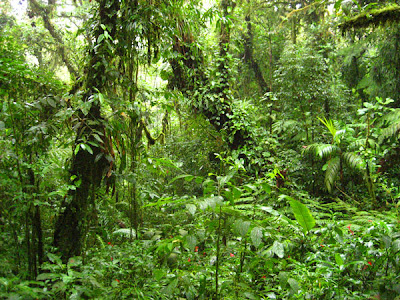After a great sleep in our ocean view room we had a leisurely morning lounging on the deck before heading up to breakfast at the open-air restaurant associated with the lodge that had an even better view than our room did:
Here we are kicking our feet up as we enjoy some delicious pancakes and tropical fruit for breakfast and soak in the view:
We had been told that visiting Malpais and not surfing was like visiting the Sistine Chapel and not looking up, so in order to avoid making that flagrant error I booked a surf lesson for that morning before setting off in the BeGo to work our way further north along the peninsula. I have done a few surfing trips in North Carolina, B.C., and Washington mostly at the prompting of my brothers who are much more into it than I am, so I am halfway competent at the basics and even own a board (which my brother made for me, thanks Trev!), but I decided that it would still be worthwhile to take a lesson as I had never benefited from any formal instruction.
The lesson was arranged through the Nalu Surf Shop with an Aussie guy named Ben as the instructor, who despite being a reasonably nice guy was quite underwhelming as an instructor. It was still fun though, and he did offer a few insights, and Playa Carmen where we did the lesson was a great place to get back into the swing of things a bit as the waves broke pretty far out and there was lots of space to practice standing by catching the whitewater or small re-formed waves. Here we are standing in the surf as Ben imparts nuggets of wisdom on what went wrong on a wave that I didn't catch ("Ah, yeah, there were lots of factors"... perfect, I'll just work on all those unnamed factors for next time):
And here I am triumphantly catching a small wave:
After the 1.5 hour lesson finished I stayed out in the surf for another hour since I was having a lot of fun. In the meantime Roanne was finally getting her relaxing beach time, reading People magazine since she hates the thought of being eaten by sharks. The beach was really nice, totally undeveloped and a great spot to spend the morning:
By the mid afternoon we decided that it was time to load up the BeGo and set out up the peninsula toward our next destination of Playa Avellanas, just south of Tamarindo. We had planned on driving up the coast, but having been warned of how bad that road was, coupled with our 4WD adventure the prior day, we decided that wisdom was the better part of valour and took the longer but faster route of driving inland on the peninsula to a more established road. We arrived in Playa Avellanas just after dark, and after a bit of searching we located our new digs at Los Villas Avellanas and checked in for a good nights sleep.
Red Jackets Covered in Dusty Grief
-
The double wide Nebo sleeping bag cover filled with treasures from our
cabin in Mazama sat on a shelf over the car for years. I had our good
friend Kyle...
1 year ago





















































